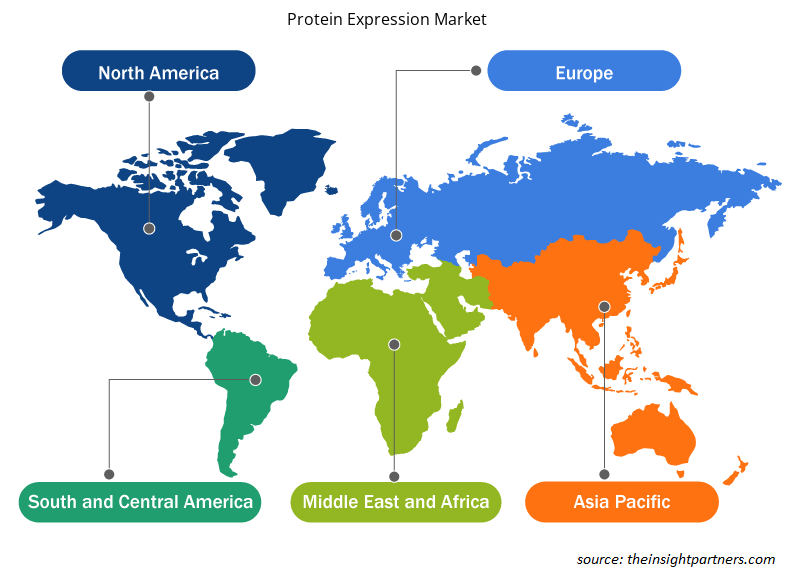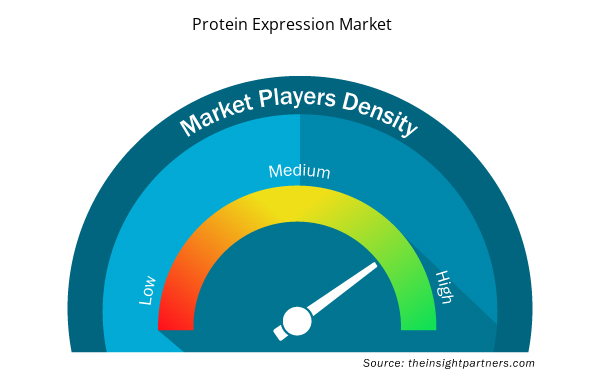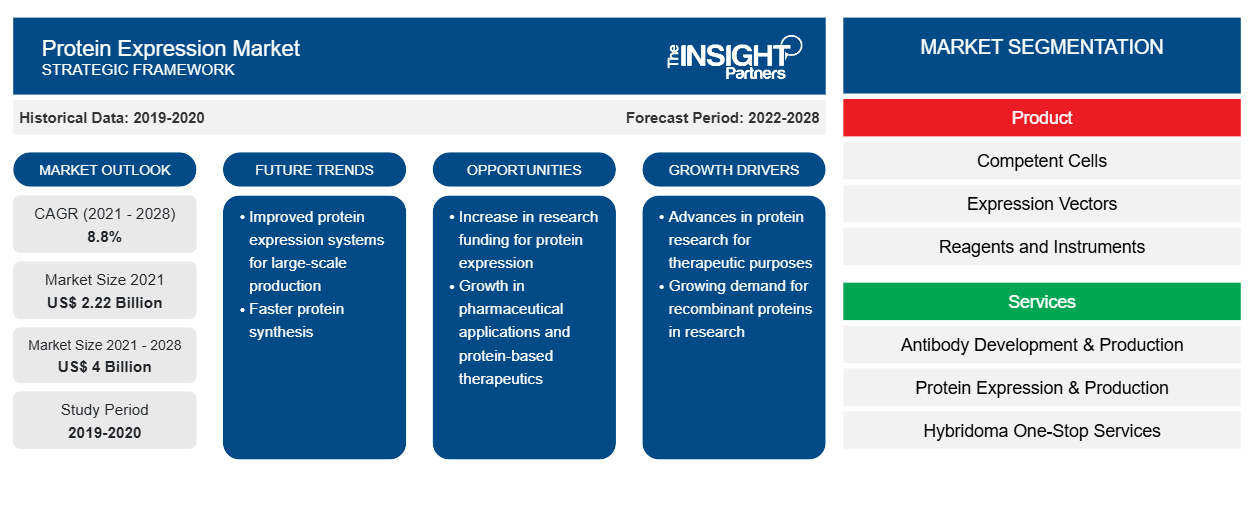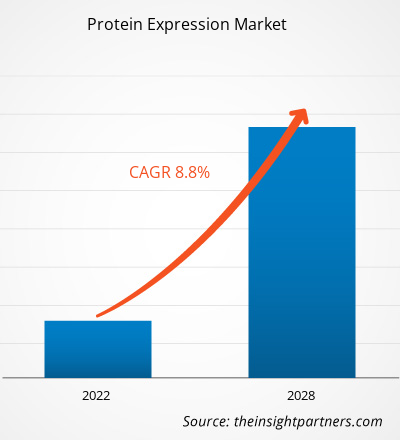Der Markt für Proteinexpression dürfte von 2.221,73 Millionen US-Dollar im Jahr 2021 auf 4.000,67 Millionen US-Dollar im Jahr 2028 anwachsen. Der Markt dürfte zwischen 2021 und 2028 mit einer durchschnittlichen jährlichen Wachstumsrate (CAGR) von 8,8 % wachsen.
Der Umfang des Proteinexpressionsmarktes umfasst Produkttyp, Dienste, Anwendung, Endbenutzer und Region. Basierend auf der Region ist der Proteinexpressionsmarkt in Nordamerika, Europa, Asien-Pazifik, Naher Osten und Afrika sowie Süd- und Mittelamerika unterteilt. Der Bericht bietet Einblicke und eingehende Analysen des Proteinexpressionsmarktes und betont dabei verschiedene Parameter wie Markttrends, technologische Fortschritte, Marktdynamik und Wettbewerbslandschaftsanalyse führender Marktteilnehmer auf der ganzen Welt. Es enthält auch eine COVID-19-Auswirkungsanalyse in den Regionen.
Markteinblicke
Zunehmende Anwendungen der Proteinexpression
Die Proteinexpression ist ein integrales Werkzeug der biologischen Forschung und wird als pharmazeutischer Produktionsmechanismus für biologische Therapeutika immer wichtiger. Die Kombination alter Technologien, wie künstlicher Enzyme, und neuer Expressionssysteme der nächsten Generation verleiht Proteinexpressionsprotokollen neuen Schwung. Die Entwicklung der Gentechnik und des Klonens hat viele Möglichkeiten für die Expression und Isolierung heterologer Proteine für Forschungszwecke eröffnet. Erhebliche technologische Fortschritte haben die Expression und Isolierung rekombinanter Proteine im großen Maßstab ermöglicht.
Die Nachfrage nach rekombinanten Proteinen für den menschlichen Gebrauch steigt von Tag zu Tag. Es besteht eine enorme Nachfrage nach neuartigen und verbesserten Bioprozessstrategien, die kosteneffektiv und zeitsparend sind. Die kontinuierliche Verbesserung biopharmazeutischer Expressionssysteme hat zur Herstellung hochwertiger Produkte geführt. Moderne molekularbiologische Techniken stehen bei der Produktion biopharmazeutischer Proteine unter Verwendung verschiedener prokaryotischer oder eukaryotischer Expressionssysteme an vorderster Front. Verschiedene innovative Techniken wie Systembiologie, Stoffwechseltechnik und CRISPR/Cas-Systeme können für die Stammtechnik eingesetzt werden, um die Leistung von Bioprozessen zu verbessern und biologisch aktive und stabile Proteine zu erzeugen.
Passen Sie diesen Bericht Ihren Anforderungen an
Sie erhalten kostenlos individuelle Anpassungen an jedem Bericht, einschließlich Teilen dieses Berichts oder einer Analyse auf Länderebene, eines Excel-Datenpakets sowie tolle Angebote und Rabatte für Start-ups und Universitäten.
- Holen Sie sich die wichtigsten Markttrends aus diesem Bericht.Dieses KOSTENLOSE Beispiel umfasst eine Datenanalyse von Markttrends bis hin zu Schätzungen und Prognosen.
Die globale Belastung durch Dengue nimmt rapide zu und wird so lange anhalten, bis ein wirksamer Impfstoff dagegen entwickelt ist. Verschiedene Impfstoffkandidaten gegen Dengue befinden sich in der präklinischen und klinischen Entwicklungsphase und basieren auf unterschiedlichen Ansätzen. Einige Impfstoffe sind tetravalente, abgeschwächte Lebendviren, gereinigte inaktivierte Viren, rekombinante Proteinuntereinheiten, Plasmid-DNA und virusbasierte Dengueimpfstoffe. Jüngste Fortschritte bei auf rekombinanten Untereinheiten basierenden Dengueimpfstoffkandidaten unter Verwendung verschiedener Ansätze, wie Fusion mit anderen immunogenen Epitopen, Verwendung eines neuartigen Adjuvans, Proteinexpression in verschiedenen Wirtssystemen, Designerimpfstoffen und VLP-Entwicklung, eröffnen neue Wege für die Entwicklung eines voll wirksamen Impfstoffs gegen Dengue.
Derzeit werden mehr als 65 Millionen bestätigte Fälle und über 1,5 Millionen Todesfälle gemeldet. Die COVID-19-Pandemie hat zu erheblichen gesundheitlichen, sozialen und globalen Wirtschaftskrisen geführt. Die Entwicklung eines Impfstoffs gegen COVID-19 ist eine wirksame Strategie zur Eindämmung des Ausbruchs. Es ist erforderlich, dass der Impfstoff mit hoher Geschwindigkeit produziert wird und leicht skalierbar ist. Um den Zeitrahmen für die Impfstoffproduktion zu verkürzen, müssen rekombinante Protein-, Virusvektor- oder Nukleinsäure-basierte (rekombinante Plasmid-DNA und mRNA) Impfstoffe in Betracht gezogen werden. Die Verwendung der Proteinexpression nimmt während der Impfstoffentwicklung aufgrund der Vorteile des rekombinanten Proteins zu, was das Wachstum des Proteinexpressionsmarktes vorantreibt.
Produkttypbasierte Einblicke
Basierend auf dem Produkttyp ist der Proteinexpressionsmarkt in Instrumente, Reagenzien, Expressionsvektoren und kompetente Zellen segmentiert. Das Reagenziensegment hielt im Jahr 2021 den größten Marktanteil. Außerdem wird geschätzt, dass das Reagenziensegment im Prognosezeitraum die höchste durchschnittliche jährliche Wachstumsrate (CAGR) von 9,5 % auf dem Markt verzeichnet.
Servicebasierte Einblicke
Basierend auf Dienstleistungen ist der Markt für Proteinexpression segmentiert in Antikörperentwicklung und -produktion, Proteinexpression und -produktion, Hybridom-One-Stop-Services, Entwicklung stabiler Zelllinien und bioanalytische Testservices. Das Segment Antikörperentwicklung und -produktion hatte 2021 den größten Marktanteil. Es wird jedoch geschätzt, dass dasselbe Segment im Prognosezeitraum die höchste durchschnittliche jährliche Wachstumsrate von 9,7 % auf dem Markt verzeichnet.
Anwendungsbasierte Erkenntnisse
Basierend auf der Anwendung ist der Markt für Proteinexpression in Forschung, Therapie und Industrie segmentiert. Das therapeutische Segment hatte 2021 den größten Marktanteil und dasselbe Segment wird im Prognosezeitraum voraussichtlich die höchste durchschnittliche jährliche Wachstumsrate (CAGR) von 9,4 % auf dem Markt verzeichnen.
Endbenutzerbasierte Erkenntnisse
Basierend auf dem Endverbraucher ist der Markt für Proteinexpression in Pharma- und Biotechnologieunternehmen, akademische Forschungsinstitute und Auftragsforschungsinstitute segmentiert. Das Segment der Pharma- und Biotechnologieunternehmen hatte 2021 den größten Marktanteil. Außerdem wird das Segment im Prognosezeitraum voraussichtlich die höchste durchschnittliche jährliche Wachstumsrate (CAGR) von 5,6 % auf dem Markt verzeichnen.
Anorganische Strategien wie Partnerschaften sowie Fusionen und Übernahmen werden häufig von Unternehmen eingesetzt, um der sich ändernden Kundennachfrage gerecht zu werden und ihren Markennamen weltweit zu behaupten. Marktteilnehmer, die auf dem Markt für Proteinexpression tätig sind, setzen auch organische Strategien wie Produkteinführung und -erweiterung ein, um ihre Präsenz und ihr Produktportfolio weltweit auszuweiten und die wachsende Nachfrage zu decken.
Regionale Einblicke in den Proteinexpressionsmarkt
Die regionalen Trends und Faktoren, die den Proteinexpressionsmarkt während des Prognosezeitraums beeinflussen, wurden von den Analysten von Insight Partners ausführlich erläutert. In diesem Abschnitt werden auch die Marktsegmente und die Geografie des Proteinexpressionsmarkts in Nordamerika, Europa, im asiatisch-pazifischen Raum, im Nahen Osten und Afrika sowie in Süd- und Mittelamerika erörtert.

- Erhalten Sie regionale Daten zum Proteinexpressionsmarkt
Umfang des Marktberichts zur Proteinexpression
| Berichtsattribut | Details |
|---|---|
| Marktgröße im Jahr 2021 | 2,22 Milliarden US-Dollar |
| Marktgröße bis 2028 | 4 Milliarden US-Dollar |
| Globale CAGR (2021 - 2028) | 8,8 % |
| Historische Daten | 2019-2020 |
| Prognosezeitraum | 2022–2028 |
| Abgedeckte Segmente | Nach Produkt
|
| Abgedeckte Regionen und Länder | Nordamerika
|
| Marktführer und wichtige Unternehmensprofile |
|
Dichte der Marktteilnehmer für Proteinexpression: Auswirkungen auf die Geschäftsdynamik verstehen
Der Markt für Proteinexpression wächst rasant, angetrieben durch die steigende Nachfrage der Endnutzer aufgrund von Faktoren wie sich entwickelnden Verbraucherpräferenzen, technologischen Fortschritten und einem größeren Bewusstsein für die Vorteile des Produkts. Mit steigender Nachfrage erweitern Unternehmen ihr Angebot, entwickeln Innovationen, um die Bedürfnisse der Verbraucher zu erfüllen, und nutzen neue Trends, was das Marktwachstum weiter ankurbelt.
Die Marktteilnehmerdichte bezieht sich auf die Verteilung der Firmen oder Unternehmen, die in einem bestimmten Markt oder einer bestimmten Branche tätig sind. Sie gibt an, wie viele Wettbewerber (Marktteilnehmer) in einem bestimmten Marktraum im Verhältnis zu seiner Größe oder seinem gesamten Marktwert präsent sind.
Die wichtigsten auf dem Proteinexpressionsmarkt tätigen Unternehmen sind:
- Thermo Fisher Scientific, Inc.
- GenScript
- Merck KGaA
- Agilent Technologies, Inc.
- Takara Bio Inc.
Haftungsausschluss : Die oben aufgeführten Unternehmen sind nicht in einer bestimmten Reihenfolge aufgeführt.

- Überblick über die wichtigsten Akteure auf dem Proteinexpressionsmarkt
Nach Produkttyp
- Kompetente Zellen
- Expressionsvektoren
- Reagenzien
- Instrumente
Nach Services
- Antikörperentwicklung und -produktion
- Proteinexpression und -produktion
- Hybridoma One-Stop-Dienste
- Entwicklung stabiler Zelllinien
- Bioanalytische Testdienste
Nach Anwendung
- Forschung
- Therapeutisch
- Industrie
Nach Endbenutzer
- Pharma- und Biotechnologieunternehmen
- Auftragsforschungsinstitute
- Akademische Forschungsinstitute
- Sonstiges
Nach Geografie
- Nordamerika
- UNS
- Kanada
- Mexiko
- Europa
- Frankreich
- Deutschland
- Italien
- Vereinigtes Königreich
- Spanien
- Restliches Europa
- Asien-Pazifik (APAC)
- China
- Indien
- Südkorea
- Japan
- Australien
- Restlicher Asien-Pazifik-Raum
- Naher Osten und Afrika (MEA)
- Südafrika
- Saudi-Arabien
- Vereinigte Arabische Emirate
- Rest von MEA
- Süd- und Mittelamerika (SCAM)
- Brasilien
- Argentinien
- Rest von SCAM
Firmenprofile
- Thermo Fisher Scientific, Inc.
- GenScript
- Merck KGaA
- Agilent Technologies, Inc.
- Takara Bio Inc.
- Bio-Rad Laboratories, Inc.
- QIAGEN
- Biolabors in New England.
- Promega Corporation
- Oxford Expression Technologies Ltd
- Historische Analyse (2 Jahre), Basisjahr, Prognose (7 Jahre) mit CAGR
- PEST- und SWOT-Analyse
- Marktgröße Wert/Volumen – Global, Regional, Land
- Branche und Wettbewerbsumfeld
- Excel-Datensatz



Report Coverage
Revenue forecast, Company Analysis, Industry landscape, Growth factors, and Trends

Segment Covered
This text is related
to segments covered.

Regional Scope
North America, Europe, Asia Pacific, Middle East & Africa, South & Central America

Country Scope
This text is related
to country scope.
Häufig gestellte Fragen
North America held highest market share in 2021.
Asia Pacific is projected to be the fastest growing region in the global market.
The costs of the Protein Expression are much higher, and they may cost US$ 300–1500, or more, per type. The cost may also differ from product to product types.
The Protein Expression market is anticipated to grow around 8.8% CAGR amid the forecast period 2021-2028.
Driving factors such as an development in the arena of proteomics and biotechnology industry, rising incidences of chronic and autoimmune diseases, rise in the awareness among people regarding protein expression, increasing focus on research and development process, growing usage of protein expression technologies in industrial protein manufacturing organizations, and rise in adoption of protein-based drugs over non-protein-based drugs are the prime growth drivers of protein expression market. In addition, increase in adoption of protein expression in emerging economies such as China, India and others, will create new opportunities for protein expression market. However, higher cost of the research and development, and complex government approval processes are the key restraints for protein expression market.
Protein expression is a process in which proteins are synthesized, modified and regulated. Protein expression involves laboratory techniques & procedures which aid in manufacture of proteins. The technique allows to produce and purify the desired protein, either inside or outside a cell. The proteins synthesized using protein expression technique can be used for industrial processes or to diagnose and to treat diseases. Protein expression provides substrates or enzymes required for further analysis
Trends and growth analysis reports related to Life Sciences : READ MORE..
The List of Companies - Protein Expression Market
- Thermo Fisher Scientific, Inc.
- GenScript
- Merck KGaA
- Agilent Technologies, Inc.
- Takara Bio Inc.
- Bio-Rad Laboratories, Inc.
- QIAGEN
- New England Biolabs.
- Promega Corporation
- Oxford Expression Technologies Ltd
The Insight Partners performs research in 4 major stages: Data Collection & Secondary Research, Primary Research, Data Analysis and Data Triangulation & Final Review.
- Data Collection and Secondary Research:
As a market research and consulting firm operating from a decade, we have published and advised several client across the globe. First step for any study will start with an assessment of currently available data and insights from existing reports. Further, historical and current market information is collected from Investor Presentations, Annual Reports, SEC Filings, etc., and other information related to company’s performance and market positioning are gathered from Paid Databases (Factiva, Hoovers, and Reuters) and various other publications available in public domain.
Several associations trade associates, technical forums, institutes, societies and organization are accessed to gain technical as well as market related insights through their publications such as research papers, blogs and press releases related to the studies are referred to get cues about the market. Further, white papers, journals, magazines, and other news articles published in last 3 years are scrutinized and analyzed to understand the current market trends.
- Primary Research:
The primarily interview analysis comprise of data obtained from industry participants interview and answers to survey questions gathered by in-house primary team.
For primary research, interviews are conducted with industry experts/CEOs/Marketing Managers/VPs/Subject Matter Experts from both demand and supply side to get a 360-degree view of the market. The primary team conducts several interviews based on the complexity of the markets to understand the various market trends and dynamics which makes research more credible and precise.
A typical research interview fulfils the following functions:
- Provides first-hand information on the market size, market trends, growth trends, competitive landscape, and outlook
- Validates and strengthens in-house secondary research findings
- Develops the analysis team’s expertise and market understanding
Primary research involves email interactions and telephone interviews for each market, category, segment, and sub-segment across geographies. The participants who typically take part in such a process include, but are not limited to:
- Industry participants: VPs, business development managers, market intelligence managers and national sales managers
- Outside experts: Valuation experts, research analysts and key opinion leaders specializing in the electronics and semiconductor industry.
Below is the breakup of our primary respondents by company, designation, and region:

Once we receive the confirmation from primary research sources or primary respondents, we finalize the base year market estimation and forecast the data as per the macroeconomic and microeconomic factors assessed during data collection.
- Data Analysis:
Once data is validated through both secondary as well as primary respondents, we finalize the market estimations by hypothesis formulation and factor analysis at regional and country level.
- Macro-Economic Factor Analysis:
We analyse macroeconomic indicators such the gross domestic product (GDP), increase in the demand for goods and services across industries, technological advancement, regional economic growth, governmental policies, the influence of COVID-19, PEST analysis, and other aspects. This analysis aids in setting benchmarks for various nations/regions and approximating market splits. Additionally, the general trend of the aforementioned components aid in determining the market's development possibilities.
- Country Level Data:
Various factors that are especially aligned to the country are taken into account to determine the market size for a certain area and country, including the presence of vendors, such as headquarters and offices, the country's GDP, demand patterns, and industry growth. To comprehend the market dynamics for the nation, a number of growth variables, inhibitors, application areas, and current market trends are researched. The aforementioned elements aid in determining the country's overall market's growth potential.
- Company Profile:
The “Table of Contents” is formulated by listing and analyzing more than 25 - 30 companies operating in the market ecosystem across geographies. However, we profile only 10 companies as a standard practice in our syndicate reports. These 10 companies comprise leading, emerging, and regional players. Nonetheless, our analysis is not restricted to the 10 listed companies, we also analyze other companies present in the market to develop a holistic view and understand the prevailing trends. The “Company Profiles” section in the report covers key facts, business description, products & services, financial information, SWOT analysis, and key developments. The financial information presented is extracted from the annual reports and official documents of the publicly listed companies. Upon collecting the information for the sections of respective companies, we verify them via various primary sources and then compile the data in respective company profiles. The company level information helps us in deriving the base number as well as in forecasting the market size.
- Developing Base Number:
Aggregation of sales statistics (2020-2022) and macro-economic factor, and other secondary and primary research insights are utilized to arrive at base number and related market shares for 2022. The data gaps are identified in this step and relevant market data is analyzed, collected from paid primary interviews or databases. On finalizing the base year market size, forecasts are developed on the basis of macro-economic, industry and market growth factors and company level analysis.
- Data Triangulation and Final Review:
The market findings and base year market size calculations are validated from supply as well as demand side. Demand side validations are based on macro-economic factor analysis and benchmarks for respective regions and countries. In case of supply side validations, revenues of major companies are estimated (in case not available) based on industry benchmark, approximate number of employees, product portfolio, and primary interviews revenues are gathered. Further revenue from target product/service segment is assessed to avoid overshooting of market statistics. In case of heavy deviations between supply and demand side values, all thes steps are repeated to achieve synchronization.
We follow an iterative model, wherein we share our research findings with Subject Matter Experts (SME’s) and Key Opinion Leaders (KOLs) until consensus view of the market is not formulated – this model negates any drastic deviation in the opinions of experts. Only validated and universally acceptable research findings are quoted in our reports.
We have important check points that we use to validate our research findings – which we call – data triangulation, where we validate the information, we generate from secondary sources with primary interviews and then we re-validate with our internal data bases and Subject matter experts. This comprehensive model enables us to deliver high quality, reliable data in shortest possible time.


 Holen Sie sich ein kostenloses Muster für diesen Bericht
Holen Sie sich ein kostenloses Muster für diesen Bericht